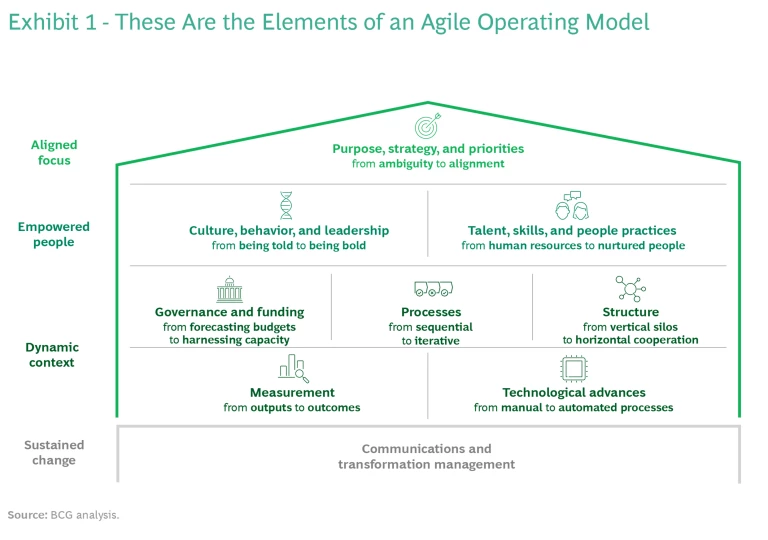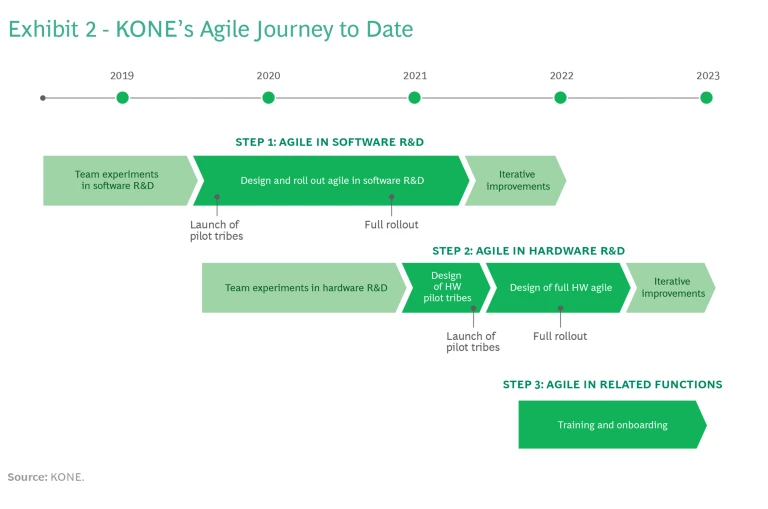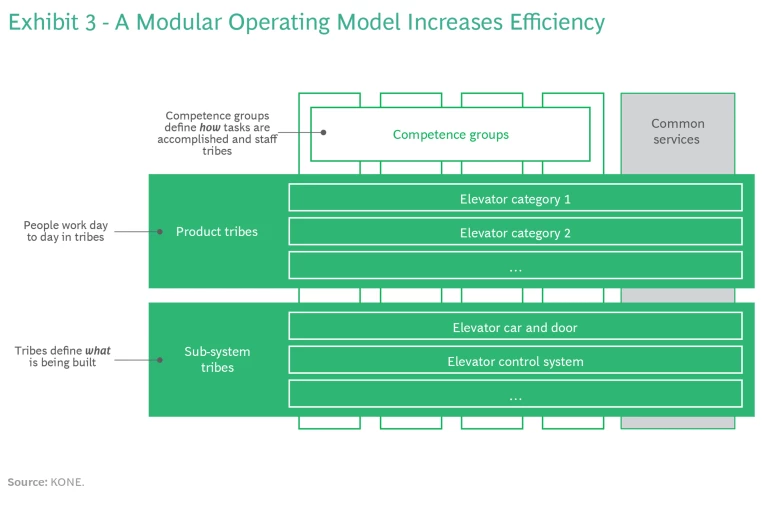Adopting an agile operating model in hardware development helps a global elevator and escalator manufacturer meet customers’ expectations for speed and innovation.
For manufacturing companies, the line between physical and digital is fading. Software, data, and services are becoming integral to these firms’ offerings, requiring changes in product-development approaches . By applying the agile approach used for software development to hardware development, companies can meet customers’ expectations for speed and innovation—shortening the typical multi-year development cycles and conferring a competitive advantage.
KONE, a global elevator and escalator manufacturer and service provider, is at the forefront of this movement. Over three years, its program for agile transformation has helped the company develop physical products faster and pursue its mission to improve the flow of urban life. Several projects completed in the first six months of 2022 would have taken years with the company’s old operating model. In this article, we share lessons from KONE’s journey and offer several takeaways for leaders who want to fast track their agile transformations and
value creation
.
Reconfiguring the Operating Model
The agile transition is not easy. For most manufacturing companies, agile is a fundamentally different way of thinking, and of organizing and executing work. It’s founded on a meticulous focus on customer value, cross-functional collaboration, and the ability to quickly incorporate a steady flow of information and respond rapidly and continuously to the changing marketplace. To make the transition and unlock agile’s full potential, leaders cannot rely only on small teams and agile routines. They must rethink the organization’s entire operating model as they incorporate agile approaches. (See Exhibit 1.)
One of the major complications with this new product-development approach is that hardware life cycles can be 20 years or even more, so mistakes have very expensive long-term implications. Software life cycles, by comparison, are much shorter, and mistakes are relatively easier to remedy.
To reap the benefits of agile, manufacturing companies can face a challenging transition.
Given the stakes, the typical agile transformation of a hardware company begins—in true agile fashion—with small steps: narrowly defined pilots, experiments, and tests of team-level agile practices. These early phases are essential to learning best practices; gaining confidence and quick wins, such as improvements in team communications and a ramp-up in speed; and building a culture of incremental improvement. Based on the results of these pilots, leaders must decide whether to scale the agile practices.
KONE’s Agile Journey
Company executives realized that for KONE to maintain its leadership position, it had to take a radical new approach to product development . It needed to shift its strategy toward becoming a physical-digital player combining world-class hardware with smart software applications. And it needed to respond to new market pressures: Customers increasingly demanded not just flexible, user-friendly, and sustainable solutions but also quicker output. As a result, KONE needed to prioritize initiatives better and get new products into the market up to three times faster than before. At the same time, the company faced increased pressure to manage costs. To address these challenges, KONE’s leadership decided to take an agile approach to an agile transformation. (See Exhibit 2.)
- First, KONE started testing agile in its software-and-services development group to learn best practices, such as breaking down silos, creating cross-functional teams, and increasing communication among team members. This allowed members of each team to work together on a daily basis to pursue developments in smaller, iterative increments.
- Second, KONE applied the software-development methodology to hardware development. The company began experiments in hardware R&D in fall 2019, launched pilot tribes in spring 2021, and launched the new hardware R&D structure on January 1, 2022. Switching to an agile structure was a major endeavor. There were 1,200 employees in six hardware R&D units spread across Asia, North America, and Europe. The agile structure depended on transitioning those teams away from a deeply ingrained geographic-based approach to a matrix model in which the six R&D units were constantly collaborating on different projects. (The use of agile for global product development is discussed in more detail below.)
- Third, KONE made sure that employees responsible for functions adjacent to product development, such as manufacturing and sourcing, were familiar and comfortable with product development’s new agile way of working. This strategy ensured that the agile teams would not be slowed down by old ways of working.
Key Features of the Agile Operating Model
Instead of sitting in a regional office with only regional responsibilities, KONE’s R&D teams are now responsible for developing and maintaining global products. They must communicate seamlessly across geographies and with adjacent functions. The challenges are significant, but the anticipated benefits of the agile approach make it worth the effort. It allows companies to:
- Give employees more autonomy to make decisions in their areas of expertise and to set priorities.
- Get closer to customers by boosting the company’s innovation capabilities , such as rapidly incorporating customer feedback.
- Speed development with leaner processes, fewer handoffs, and streamlined governance so that cross-functional teams can work iteratively with faster feedback loops.
- Achieve greater efficiencies by setting clear priorities and introducing flexibility into daily operations .
Several key features of agile operations enable these benefits—and more.
Organization into Global Tribes. One key feature of KONE’s new agile operating model is that global “tribes” take full ownership of their products from concept to sunsetting. No person is a permanent member of a single global tribe but belongs to a competence group and can be flexibly moved to another tribe when business priorities change. Competence groups define how tasks (such as setting engineering standards and approaches) are accomplished, assign employees to teams in tribes, and look after employees’ professional development. This “competence-based” approach ensures that the right team and resources are assembled for each project.
With agile, the global-tribe structure encourages ownership and flexibility.
By breaking up regional fiefs and creating more flexible team structures, KONE has boosted the engagement of employees, most of whom take enormous pride in working on projects with a global impact. This approach widens an employee’s expertise and opens career pathways.
A Modular Approach. KONE also established product tribes for core platforms, such as different types of elevators, and sub-system tribes for the components these global products share, such as an elevator car and door, and a control system. This modularizes and harmonizes the global product portfolio and the platforms upon which those products are built—another key feature of agile organizations . (See Exhibit 3.) In the past, different regional teams at KONE often duplicated one another’s efforts by working simultaneously on similar or identical projects. Now, engineering efforts are coordinated and completed just once to benefit the global organization. When differentiation does not add significant value, harmonization reduces waste significantly.
Autonomy. To streamline product development, KONE leaders realized that they needed to reduce their day-to-day oversight and empower teams to make more decisions. To achieve this goal, leaders articulate company priorities during quarterly meetings and allocate resources for meeting them. Equipped with these resources, teams can align their activities with company priorities. Of course, there is still oversight, but the new portfolio tools allow leadership to monitor progress from afar without interrupting it. For example, the project development teams regularly organize demos in which they show leaders and stakeholders what they have been working on.
Perspective. The agile operating model, particularly the greater autonomy given to global teams, has transformed how leadership spends its time. Before, the leadership team was often mired in execution details. Now it has more time to step back, think, and strategize, and to brainstorm about the next month, quarter, and year.
Focus. Previously, hardware developers had to work on seven to ten projects at a time, leading to stretched resources, delays, and escalating expenses as the company hired subcontractors to do more of the work. With the agile model, projects are prioritized more easily and with greater certainty, enabling hardware-development teams to focus on two to three projects at a time. The result is more efficient resource allocation within the team and much faster throughput of projects.
Nine Takeaways for Leaders
KONE launched the new hardware R&D structure at the start of 2022, so it’s still early days. But the results have been impressive so far. Several projects completed in the first six months of 2022 would have taken years in the old structure. For example, in one overseas market the government imposed a sudden regulatory requirement on KONE’s customers in the summer of 2022. Thanks to KONE’s competence-based organization and overall agile structure, it was able to bring a solution to market in three weeks instead of what probably would have taken several months.
We have identified nine lessons that can be learned from KONE’s journey.
Accept that differences between hardware and software development will persist. Agile ways of working are not as natural in hardware development and manufacturing as in software development, and it will take time to embed this new mindset. For example, the physical nature of hardware makes the cost of mistakes much higher. Design errors can’t be fixed online; often, they must be fixed on site.
Organize for autonomy. The less teams and tribes must consult or rely on others during day-to-day operations, the more efficiently they can work toward goals. To organize for autonomy, a company must understand this web of dependencies and design team structures that minimize them.
Recognize that product-development changes have companywide implications. These implications include how product-development teams gather input from managers of business lines and from sourcing and manufacturing divisions—and how they interact with them. To some degree, product development must educate other parts of the company about its new agile approach. To do so, they should include leaders from these other parts in the agile teams and agile governance.
Synchronize different development cycles. A one-size-fits-all approach does not work for development cycles. For example, a company could update an online portal for elevator management every week. But it could take several years to develop a new elevator motor. Having different, but synchronized, cycles for various types of development allows each group to run at its best possible speed.
Ensure that leaders change behavior. Change is not just hard for employees. It can be even harder for leaders who have spent the bulk of their careers doing things a certain way. It’s important to drive a culture and mindset of continuous learning and innovation from the top down .
Embrace the flexibility. Once an agile operating model is in place, change is easier—including changes to the model itself. Indeed, to get the full benefit of agile, a company should adopt an “ always-on transformation ” mindset to keep evolving the operating model. Based on lessons learned during the first year of agile operations, KONE went through several iterations of its own model.
Don’t underestimate the upfront preparations. Big changes take lots of effort and upfront preparation. For example, it takes serious commitment to clarify portfolio priorities and assign them to tribes. Before and during the agile transformation, companies must also invest the necessary time and resources in training and coaching.
Be prepared for cultural differences. This is especially true for global companies. For example, engineers in some parts of the world might immediately enjoy the autonomy and flexibility that come with agile ways of working. But engineers elsewhere might take longer to get comfortable working in a less hierarchical structure.
When the time comes, move decisively. Moving to an agile hardware-development model can be a scary leap of faith because it’s a change that’s not easily reversed. But when the time comes to make the switch, do so quickly and avoid a “hybrid mode” in which product-development teams are operating differently from one another. This can quickly sow confusion and undercut confidence in the entire agile endeavor.
As hardware and software converge, and as connectivity becomes instrumental to many offerings, manufacturing companies need to recast their hardware development so that it’s more in line with the agile approach used in software development. The switch is not simple. But with the help of agile, companies such as KONE are keeping development efforts in sync and meeting customers’ expectations for speed and innovation.









